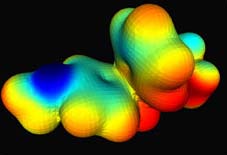New Software Developed at Rensselaer Predicts Promising Ingredients for New Drugs

The DDASSL software can quickly screen large databases, accurately predicting the molecules that show potential for future medicines. <br>
Program speeds drug discovery
Researchers at Rensselaer Polytechnic Institute today announced the release of a software program capable of quickly identifying molecules that show promise for future medicines. The software program enables drug makers to comb through enormous databases of potential molecules and identify the ones that have sound medicinal properties.
Rensselaer researchers with skills in computer science, chemistry, and math allied to create the software program. Chemistry Professor Curt Breneman, Mathematics Associate Professor Kristin Bennett, and Decision Sciences and Engineering Systems Associate Professor Mark Embrechts collaborated in the Drug Discovery and Semi-Supervised Learning project (DDASSL, pronounced “dazzle”), supported by a $1.2 million Knowledge and Distributed Intelligence Award from the National Science Foundation.
“The trick with drug discovery is to have the drug molecule fit like a key in a lock, because shape affects its performance,” Embrechts said. The safety and effectiveness of medicines depend on the shape and chemistry of the molecule. To find the most likely molecules, the new software makes use of two shortcuts in chemistry and math that enable the computer to search a vast molecular database rapidly.
The first shortcut describes the molecule, its shape and chemistry, in terms of numbers a computer can crunch rapidly. “Dr. Breneman has a technique to calculate electronic properties on the surface of a molecule very quickly,” Embrechts said. “It produces a description—basically a set of numbers—that the computer can use easily.”
Then, the second shortcut identifies which molecules have the right chemistry for a specific therapy. Using advanced pattern-recognition techniques known as kernel methods, the software analyzes a small sample database to identify molecules with the right chemical features. Once the key features are identified, the software can quickly screen large databases, accurately predicting the molecules that show potential.
“Conventional techniques are not truly predictive and don’t work,” Bennett said. “So we borrowed pattern recognition techniques already used in the pharmaceutical industry and added algorithms based on support vector machines. That gives us a technique to predict which molecules are promising.”
Rensselaer researchers noted that predictive modeling is one of a new breed of drug discovery methods that marks a shift in industry practice—a shift away from cell-based assays performed in the lab toward math-based models calculated on the computer.
“Our program allows researchers to ‘crash test’ lots of molecules quickly and inexpensively,” Breneman said. “That prevents a lot of false starts. The ultimate pay-off of this methodology may be that it can support the rapid invention of new drugs when diseases develop quickly and threaten society.”
As drug makers increasingly target complex, chronic illness, drug development becomes far more costly and time consuming. Meanwhile, in the search for new drugs, 99.9 percent of compounds tested ultimately fail. Accordingly, drug makers want to be able to predict more accurately which compounds will produce the next blockbuster drug.
The Rensselaer research team will continue work to improve drug discovery methods, which will be carried out in the new Rensselaer Center for Biotechnology and Interdisciplinary Studies, a state-of-the-art facility scheduled to open in September 2004.
About Rensselaer
Rensselaer Polytechnic Institute, founded in 1824, is the nation’s oldest technological university. The school offers degrees in engineering, the sciences, information technology, architecture, management, and the humanities and social sciences. Institute programs serve undergraduates, graduate students, and working professionals around the world. Rensselaer faculty are known for pre-eminence in research conducted in a wide range of research centers that are characterized by strong industry partnerships. The Institute is especially well known for its success in the transfer of technology from the laboratory to the marketplace so that new discoveries and inventions benefit human life, protect the environment, and strengthen economic development.
Media Contact
More Information:
http://www.rpi.edu/web/News/press_releases/2004/ddassl.htmAll latest news from the category: Information Technology
Here you can find a summary of innovations in the fields of information and data processing and up-to-date developments on IT equipment and hardware.
This area covers topics such as IT services, IT architectures, IT management and telecommunications.
Newest articles

NASA: Mystery of life’s handedness deepens
The mystery of why life uses molecules with specific orientations has deepened with a NASA-funded discovery that RNA — a key molecule thought to have potentially held the instructions for…

What are the effects of historic lithium mining on water quality?
Study reveals low levels of common contaminants but high levels of other elements in waters associated with an abandoned lithium mine. Lithium ore and mining waste from a historic lithium…

Quantum-inspired design boosts efficiency of heat-to-electricity conversion
Rice engineers take unconventional route to improving thermophotovoltaic systems. Researchers at Rice University have found a new way to improve a key element of thermophotovoltaic (TPV) systems, which convert heat…



